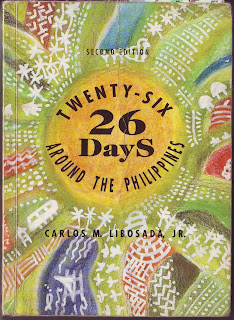13 May 2009
It's been 10 hours since the bus left the Araneta Center station in Cubao, Quezon City but it hasn't reached its destination: Legazpi City. The reason for the delay, I think, is the numerous stopovers that seem to be much more than the usual. Meanwhile, I await the sight of the Mayon Volcano, which is, of course, the main reason why I'm here. I stir as I see an image of what looks like a mountain shrouded by clouds. Pero bakit hindi naman perfect cone? But before I can wallow in disappointment, a similar image appears from afar and as the clouds move away from the mountain, the famous perfect cone is revealed. Suddenly it doesn't matter anymore if the trip is taking two hours more than it should.
At 9 a.m., the bus finally makes it to the terminal. Ignoring the small crowd of men offering to carry the passengers' baggage and take them to a waiting vehicle that will drive them to their destination, I go straight to the queue of tricyles, which sadly do little for me in avoiding getting gypped. I'm still charged a lot more than the usual fare but at least I easily get to Hotel Rex, the recommendation of the book, "Twenty-six Days Around the Philippines." Sensing my hesitation in checking in, the driver assures me that a lot of travelers stay there as well. As I walk into the reception area manned by two affable female attendants, all my reservations vanish. I tell them why I choose to stay at Hotel Rex; they can't believe of its citation in the book.
Since I wasn't able to really sleep throughout the 12-hour bus ride, which is actually normal for someone who can't get some shuteye however long the trip is unless thoroughly tired, I decide to spend more time in my Php500-a-night room that has two single beds, a TV and electric fan (I only have to pay 300 pesos more for the other room with an air-conditioning unit but I opt to feel the breeze that gets in through the large windows). By 3 p.m., I'm off to see the sights but not without asking for directions and tips (e.g. jeepney fare) from the reception staff.
My first stop is the Cagsawa Ruins Park, located in Daraga, Albay, which offers an unobstructed view of the famed volcano:

It's true what they say about the majesty of Mayon but I think it's best appreciated and experienced during a climb. I may never do that so I find utter satisfaction of having my photo taken with the Mayon in the background. There are kids and adults offering their photographic services like making it appear that the tourist is touching the peak of the volcano, which I balk at but I still have to pay a couple of pesos to a kid who takes my "normal" photo with the volcano.
For the longest time since Mayon Volcano had its worst eruption on Feb. 1, 1814 that had its flowing lava engulfing the Cagsawa Church along with the parishioners who took refuge there, the church belfry -- the only thing that survived the tragedy -- was made the iconic symbol of nature's wrath. Now there's a literal icon that stands guard near the gate of the park:
 A
Afterwards, I try to find the old existing church back in Legazpi City that my friend Che, a native of Naga City, which is about two hours away from Legazpi City, had suggested that I visit. Unfortunately, she had forgotten the name of the church but I think she's referring to the Albay Cathedral, which is, like in most provinces and towns across the nation, situated near the provincial or town hall and plaza that remains the center of activities.
Thankfully, I'm successful at following Che's other suggestion that is to dine at Small Talk even if I just had sizzling bangus with pinangat for dinner at a nearby eatery. I order laing pizza, which I imagine to be even yummier without pineapple bits, and pili pie.
 (It was only the day before, when I was on my way to Donsol, that I realized that I could go to Masbate, after all. While still at the Araneta Center station in Quezon City, where I took a bus going to Bicol, I saw an advertisement of a direct trip via RORO (roll-on, roll-off) in Pilar to Masbate. At that time, I still didn't know where Pilar was and how I could get there from Donsol. But as soon as I found out that those towns were adjacent to each other and Lola Erna supplied me with info on the schedule of the boat trips, I immediately contacted a cousin in Masbate and told her about my visit.)
(It was only the day before, when I was on my way to Donsol, that I realized that I could go to Masbate, after all. While still at the Araneta Center station in Quezon City, where I took a bus going to Bicol, I saw an advertisement of a direct trip via RORO (roll-on, roll-off) in Pilar to Masbate. At that time, I still didn't know where Pilar was and how I could get there from Donsol. But as soon as I found out that those towns were adjacent to each other and Lola Erna supplied me with info on the schedule of the boat trips, I immediately contacted a cousin in Masbate and told her about my visit.) 

 This turns into a magical place during an evening river cruise (fee: PhP200) as countless fireflies converge on treetops and the sky is blanketed with stars of all sizes.
This turns into a magical place during an evening river cruise (fee: PhP200) as countless fireflies converge on treetops and the sky is blanketed with stars of all sizes.





